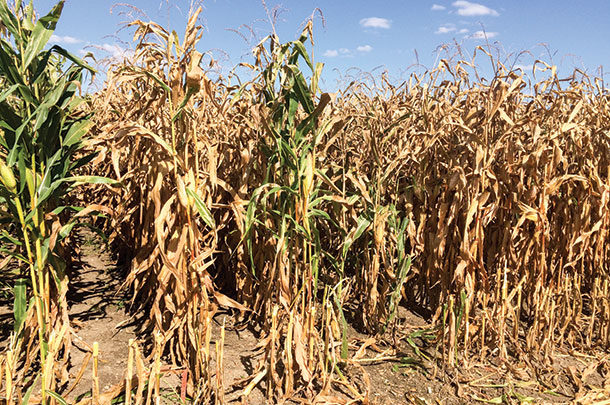Use this article as your guide to help you determine if you should apply fungicide to your corn silage this year.
How does foliar disease affect my corn silage crop?
- Foliar disease reduces the photosynthetic ability of the plant, which in turn will reduce yield. With reduced kernel production there will be less starch, which is responsible for up to 60 percent total yield and 50 percent digestible energy of the corn silage crop.
- Healthy leaves contribute up to 10 percent of the total silage yield and provide approximately 7 percent of the digestible energy in corn silage. With less leaf material due to disease, digestible fibre of the silage may also be reduced.
- Although leaf material may appear dry due to presence of disease, the stalk may still hold a high amount of moisture. This can make it difficult to achieve consistent chop length, and thus, both packing in the silo or bunk and feed sorting can be a problem.
- Leaf disease can lead to inconsistency in moisture and quality of corn silage. This inconsistency will create problems regarding harvest, storage and accurate ration formulation.
How does fungicide work?
There are two types of fungicides commonly used in corn: triazole and strobilurin fungicides. Triazoles are used for controlling fungal growth of Gibberella ear rot and other mycotoxin-producing molds. Strobilurins are used for the prevention and reduction of foliar leaf diseases. Foliar applied fungicides require adequate leaf coverage for disease protection. The more rapidly the fungicide is absorbed and distributed throughout the leaf, the more complete the coverage and protection. Fungicides should be applied as a preventative treatment when environmental conditions for disease development exist.
When is fungicide applied?
Fungicides should always be applied according to the label rate and crop stage recommendations. DuPont Pioneer field studies in Canada and the U.S. have shown that the most effective application timing for controlling foliar leaf disease was from tassel stage to first stage of grain fill (R1) based on the years and products that were tested.
Under what conditions should I spray fungicide?
The return on investment (ROI) for spraying fungicide was initially debatable. However, more research over the past few years is showing more results that support producers to consider fungicide use. DuPont Pioneer conducted trials in 2015 on corn silage to analyze the yield and quality impact of fungicide application. Both corn-on-corn and corn-after-alfalfa acres, as well as hybrids with good resistance to NCLB and anthracnose, were used in the trial. Of the eight side-by-side trials conducted in western Ontario in 2015, you can see the variance in results seen on the different farm locations in Figure 1.

An average 0.8 ton per acre yield advantage was realized, with five of the eight locations showing improved milk per acre and milk per ton as shown in Figure 2. There was no difference in dry matter. The average plot location would see a $132.77 per acre benefit to forage yield and quality, based on $4.50 per bushel grain price and corn silage value of $65 per ton. The range in ROI is from -$195 to $260. This supports the recommendation that fungicide ROI will depend on your corn hybrid selection and management practices.

How do I determine if fungicide is needed?
Scout for foliar disease in corn just prior to tassel emergence. Answer the questions in the corn fungicide decision guide (Figure 3). If the answer is “yes” to five or more of the questions, your ROI for applying a fungicide is likely high.
Selecting the best corn hybrid at planting, followed by regular field scouting, can help ensure the highest production of corn silage. Familiarizing yourself with common diseases and understanding the disease risk factors is key to determining treatments in order to maximize yields and profitability of your corn silage. PD
References omitted but available upon request. Click here to email an editor.
Ashley Hall is a dairy specialist for DuPont Pioneer. Email Ashley Hall.
PHOTO: Fungicides can be used to control fungal growth and reduce foliar leaf disease to help ensure the highest production of corn silage. Photo provided by DuPont Pioneer.











